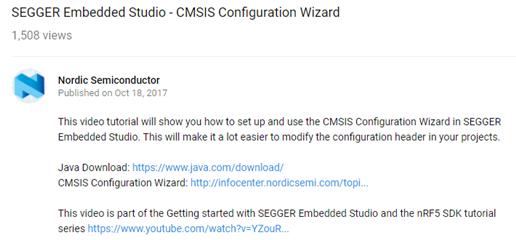
- #Segger embedded studio tutorial install#
- #Segger embedded studio tutorial full#
- #Segger embedded studio tutorial code#
- #Segger embedded studio tutorial download#
- #Segger embedded studio tutorial windows#
#Segger embedded studio tutorial install#
Install J-Link Software and Documentation Pack.
#Segger embedded studio tutorial windows#
#Segger embedded studio tutorial code#
To translate the C/C++ source code into a hex file for your microprocessor, you will need to compile it. It usually only advertises a few beacon signals, but with a few modifications it can be changed into any project. The base project used to start development is acnBEACON. This modified SDK version is a part of our codebase too and the source code for it can be found here: The Firmware of our products is also based on an RTOS (Real-Time Operating System) called freeRTOS, thus some modifications are needed official Nordic SDK to fit our requirements (don’t worry, we already did that). More info about it, its APIs and examples can be found here. aconno products are based on Nordic Semiconductors nRF528xx chips, thus we use their SDK (Software Development Kit) as a base for our projects. For example, in our codebase, you can find firmware source code for acnSENSA, acnRANGE, etc. Other than these libraries you can also find finished firmware projects related to our hardware products. The aconno codebase consists of many libraries developed by our programmers to support all the sensors used on our products. To use the commands just close and reopen your terminal.$ export PATH="$PATH:$HOME/opt/gcc-arm-none-eabi-VERSION/bin" To do this you will want to add the following to your ~/.bashrc file.
#Segger embedded studio tutorial full#
#Segger embedded studio tutorial download#
First download the software package for your desired platform (in this case win32) here: Windows source, run the installer and set the PATH variables. The installation process on Windows is easy. Since it’s cross-compiling, you can use either Windows, macOS or Linux based operating systems. Here at aconno, we use the GNU GCC arm-none-eabi-gcc compiler for the cross-compiling process.

In order to translate the source code into a hex file (hex file is a special binary format that your microprocessor understands, zeros and ones), you need to use a special program – the compiler. We recommend following this tutorial carefully step by step in order to set up an environment that will enable you to edit, compile and flash aconno projects. For that, you will need the ARM toolchain (which contains the compiler), Nordic’s SDK (Software Development Kit), the aconno codebase, an editor (preferably an IDE or specialized code editor), and a SEGGER J-Link device or an aconno programmer (to transfer the code to your device). Still, you might want to make some changes to it. The aconno firmware is highly configurable using the aconno Sensorics app.


 0 kommentar(er)
0 kommentar(er)
